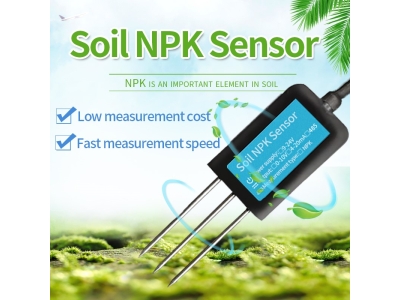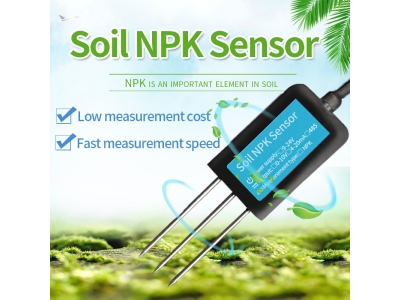Modern agriculture faces the challenge of meeting the ever-increasing demand for food while minimizing its impact on the environment. Sustainable land management is crucial to achieve this delicate balance. Soil sensors have emerged as a game-changer in agricultural practices, providing farmers with real-time data to optimize resource allocation, improve crop yield, and promote sustainable farming. This article explores the revolutionary potential of soil sensors in transforming farming practices for sustainable land management.
The Significance of Sustainable Land Management:
Sustainable land management aims to optimize agricultural productivity while preserving natural resources for future generations. It involves practices that protect soil health, enhance biodiversity, conserve water, reduce greenhouse gas emissions, and mitigate climate change impacts. By adopting sustainable land management strategies, farmers can ensure both economic viability and environmental stewardship.

Understanding Soil Sensors:
Soil sensors are innovative devices that measure and monitor various soil properties to provide valuable insights into soil health and conditions. They facilitate data-driven decision making by farmers and agronomists, enabling them to make informed choices regarding irrigation, fertilization, and crop management.
Key Parameters Monitored by Soil Sensors:
Soil sensors measure several critical parameters that influence crop growth and overall soil health. Some key parameters include:
a. Soil Moisture: Soil moisture sensors measure the water content in the soil, allowing farmers to optimize irrigation practices based on actual soil conditions. This minimizes water waste, improves water-use efficiency, and prevents over or under-watering, leading to healthier crops and reduced environmental impact.
b. Soil Temperature: Monitoring soil temperature helps farmers determine optimal planting times and track soil temperature fluctuations. It enables farmers to make informed decisions regarding crop selection, timing, and management practices, minimizing the risk of crop stress and increasing yield potential.
c. Soil Nutrients: Soil nutrient sensors measure the concentration of essential nutrients such as nitrogen, phosphorus, and potassium in the soil. This data assists farmers in precisely applying fertilizers according to crop requirements, minimizing nutrient loss, reducing environmental pollution, and optimizing plant nutrition.
d. Soil pH: Soil pH sensors measure the acidity or alkalinity of the soil, providing insights into soil fertility and nutrient availability. Farmers can adjust soil pH to create optimal conditions for specific crops, leading to improved nutrient uptake and healthier plants.
Benefits and Applications of Soil Sensors: Soil sensors offer numerous benefits and applications that revolutionize farming practices:
a. Precision Irrigation: Real-time soil moisture data enables farmers to implement precision irrigation, delivering water precisely when and where it is needed. This reduces water usage, increases efficiency, promotes healthy root development, and mitigates soil erosion.
b. Efficient Nutrient Management: Soil nutrient sensors provide accurate measurements of nutrient levels, allowing farmers to fine-tune fertilizer application. This helps prevent over-fertilization, reduces nutrient runoff, enhances nutrient use efficiency, and minimizes environmental pollution.
c. Crop Health Monitoring: Soil sensors help detect early signs of plant stress, such as water or nutrient deficiencies. Timely intervention based on sensor data empowers farmers to optimize crop health management, detect disease or pest infestations, and take preventive measures to safeguard harvests.
d. Sustainable Land Use: By monitoring soil conditions, farmers can make informed decisions about land use planning, crop rotation, and conservation practices. Soil sensors aid in identifying suitable crops for different soil types, optimizing resource allocation, and minimizing soil degradation.
Integration with Digital Agriculture Technologies: Soil sensors can be integrated with advanced digital agriculture technologies to enhance their capabilities and impact:
a. Internet of Things (IoT) Connectivity: IoT-based soil sensors enable real-time data collection and transmission, allowing farmers to access information remotely. This connectivity facilitates automated decision-making processes, remote monitoring, and timely interventions.
b. Data Analytics and Machine Learning: Soil sensor data, when combined with advanced analytics and machine learning algorithms, can generate valuable insights. These insights help farmers identify patterns, predict soil conditions, optimize resource allocation, and make proactive management decisions.
c. Decision Support Systems: By integrating soil sensor data with decision support systems, farmers gain access to comprehensive databases, models, and recommendations. This aids in making data-driven decisions, improving farming practices, and optimizing environmental outcomes.
Conclusion:
Soil sensors are revolutionizing farming practices by allowing farmers to monitor and manage soil health in real-time. With the ability to measure soil moisture, temperature, nutrients, and pH levels, these sensors enable data-driven decision making for enhanced water and nutrient management, improved crop health, and sustainable land use. The integration of soil sensors with digital agriculture technologies further enhances their potential in optimizing resource allocation, reducing environmental impact, and achieving sustainable land management. As farmers embrace the power of soil sensors, they pave the way towards a more sustainable and productive future for agriculture and the environment.






